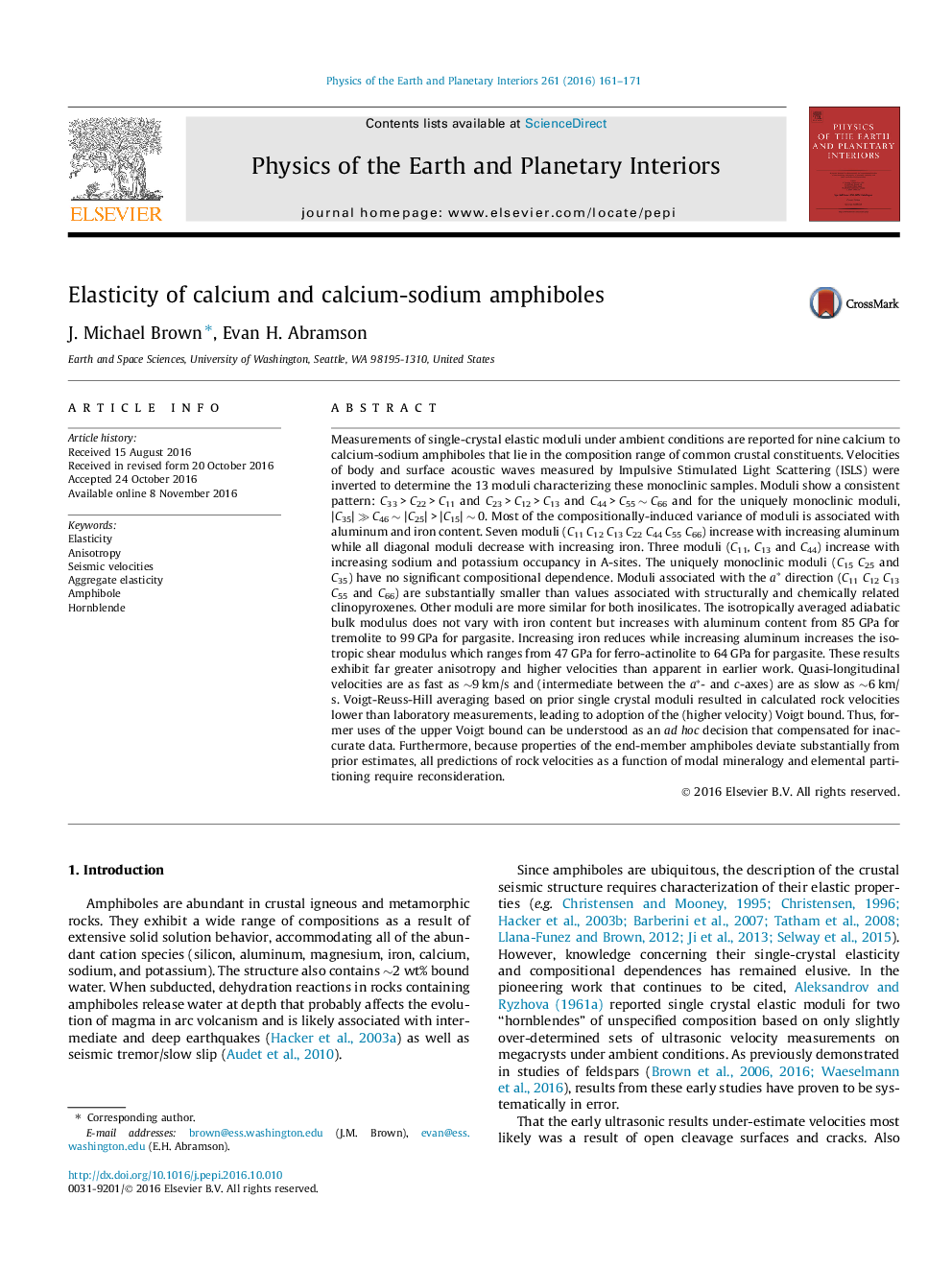| کد مقاله | کد نشریه | سال انتشار | مقاله انگلیسی | نسخه تمام متن |
|---|---|---|---|---|
| 5787331 | 1641479 | 2016 | 11 صفحه PDF | دانلود رایگان |
عنوان انگلیسی مقاله ISI
Elasticity of calcium and calcium-sodium amphiboles
ترجمه فارسی عنوان
انعطاف پذیری آمفیبولهای کلسیم و کلسیم سدیم
دانلود مقاله + سفارش ترجمه
دانلود مقاله ISI انگلیسی
رایگان برای ایرانیان
کلمات کلیدی
قابلیت ارتجاعی، ناهمسانگردی، سرعت لرزه ای، الاستیک انبوه، آمفیبول، هورنبلند،
موضوعات مرتبط
مهندسی و علوم پایه
علوم زمین و سیارات
فیزیک زمین (ژئو فیزیک)
چکیده انگلیسی
Measurements of single-crystal elastic moduli under ambient conditions are reported for nine calcium to calcium-sodium amphiboles that lie in the composition range of common crustal constituents. Velocities of body and surface acoustic waves measured by Impulsive Stimulated Light Scattering (ISLS) were inverted to determine the 13 moduli characterizing these monoclinic samples. Moduli show a consistent pattern: C33 > C22 > C11 and C23 > C12 > C13 and C44 > C55 â¼Â C66 and for the uniquely monoclinic moduli, |C35| â«Â C46 â¼Â |C25| > |C15| â¼Â 0. Most of the compositionally-induced variance of moduli is associated with aluminum and iron content. Seven moduli (C11C12C13C22C44C55C66) increase with increasing aluminum while all diagonal moduli decrease with increasing iron. Three moduli (C11, C13 and C44) increase with increasing sodium and potassium occupancy in A-sites. The uniquely monoclinic moduli (C15C25 and C35) have no significant compositional dependence. Moduli associated with the aâ direction (C11C12C13C55 and C66) are substantially smaller than values associated with structurally and chemically related clinopyroxenes. Other moduli are more similar for both inosilicates. The isotropically averaged adiabatic bulk modulus does not vary with iron content but increases with aluminum content from 85 GPa for tremolite to 99 GPa for pargasite. Increasing iron reduces while increasing aluminum increases the isotropic shear modulus which ranges from 47 GPa for ferro-actinolite to 64 GPa for pargasite. These results exhibit far greater anisotropy and higher velocities than apparent in earlier work. Quasi-longitudinal velocities are as fast as â¼9 km/s and (intermediate between the aâ- and c-axes) are as slow as â¼6 km/s. Voigt-Reuss-Hill averaging based on prior single crystal moduli resulted in calculated rock velocities lower than laboratory measurements, leading to adoption of the (higher velocity) Voigt bound. Thus, former uses of the upper Voigt bound can be understood as an ad hoc decision that compensated for inaccurate data. Furthermore, because properties of the end-member amphiboles deviate substantially from prior estimates, all predictions of rock velocities as a function of modal mineralogy and elemental partitioning require reconsideration.
ناشر
Database: Elsevier - ScienceDirect (ساینس دایرکت)
Journal: Physics of the Earth and Planetary Interiors - Volume 261, Part B, December 2016, Pages 161-171
Journal: Physics of the Earth and Planetary Interiors - Volume 261, Part B, December 2016, Pages 161-171
نویسندگان
J. Michael Brown, Evan H. Abramson,
